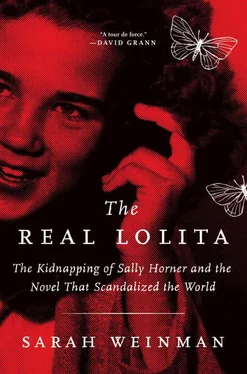The cultural climate had shifted back and forth between liberal progressiveness and conservative backlash in the intervening thirty-five years, but in 1997 the appetite for a new film version was particularly low. Lyne had tried and failed to make the film for years. Once he had finally finished shooting, he faced fresh legal issues, after the passage of the Child Pornography Prevention Act of 1996, which made illegal any visual depictions of children having sex with adults—whether or not a child was involved.
Lyne battled lawyers seeking significant cuts to the film and struggled to find a distributor, which delayed Lolita ’s opening in North American theaters by more than a year. The theatrical run was tiny (to qualify for the Academy Awards) and a prelude to an airing on the cable television network Showtime. This Lolita, as a result, did even poorer box office business than its predecessor. Once more, the general public did not have much appetite for seeing Lolita on-screen, as opposed to imagining her within the covers of a book.
More than sixty years on, the appetite for adapting Lolita or reviving earlier adaptations has likely subsided for good. It is difficult to see how it could be done, especially given the growing polarization of the political climate. The dark heart of Lolita, and the tragedy of Dolores Haze, may now be too much to transform into entertainment. It’s wiser, and saner, to remember the little girl at the center of the novel, and all of the real girls, like Sally Horner, who suffered and survived.
Epilogue
On Two Girls Named Lolita and Sally
Both times I met with Sally Horner’s niece, Diana Chiemingo, she picked me up at the Burlington Towne Center light rail station in New Jersey and drove us a mile down the road to Amy’s Omelette House, which does, in fact, specialize in omelets. Diana turned seventy in August 2018. Her figure is slight and her voice does not carry, but both convey a steely toughness. She gets to a point quickly and is not prone to running on. Silences often stretched between us as she considered how to phrase her answers in just the right way.
Sally is never far from her niece’s thoughts. It was particularly apparent in our first face-to-face meeting in the summer of 2016. Each of us arrived at the diner with photos to show the other. Diana brought a stack of black-and-white images of Sally, Susan, Al, Ella, and others—her best friend, Carol, Sally’s unidentified date for the evening social, probable classmates at Burrough Junior High, possible acquaintances from her last summer. Both Diana and I marveled at what a fully grown, vibrant girl Sally appeared to be. A vibrancy that had so little time to assert itself.
Then it was my turn. My photos—grainy images scanned from the Courier-Post coverage of Sally’s rescue—were nowhere near in as good condition as Diana’s trove. But I knew she needed to see the one of her, not quite two, sitting with her parents as Susan speaks to Sally on the telephone, hours after her younger sister’s rescue in San Jose. Diana was startled by the photograph—she had never seen it before. Seeing her and her family all together, so long ago, made Sally’s story feel fresher, more vivid. The tragic parts, but also the happier parts. Sally had come home and was part of their family again, even if it wasn’t for very long.
Diana spoke of her parents, of her grandmother Ella, of her own life. The family tried to hold Sally’s abrupt loss at bay with mixed results. She became, and remained, the family phantom. For a long time, Diana had no inkling of the Lolita connection. She’d never read the novel, so of course she would not have seen the reference to her aunt in the text. She learned of the connection when her brother, Brian, a police department evidence technician in Florence, searched online and discovered Sally’s sparse Wikipedia entry as well as the essay by Alexander Dolinin.
“He was shocked,” Diana told me. “I was, too. I don’t know how to explain it. To think that someone is writing about your family? I was so young when everything happened, and for people to be writing about Sally—that’s a really big thing.”
By our second face-to-face meeting, nearly a year later, Diana had had more time to sit with the idea that Sally’s story was part of a larger mosaic of girls and women who had been cruelly wronged and abused by men. Stigmas take a long time to fade. But the more Diana talked about her aunt, the more the relief, and even the joy, showed through to compensate for what she, her family, and Sally had lost.
LOLITA ’S POST-PUBLICATION afterlife meant that years later, Vladimir Nabokov was still being asked about the novel, again and again, in interviews. He did not like this. The irritation is evident, leading to contradictory responses about what influenced him. He denied Humbert Humbert had a real-life basis, despite his repeated chess matches with Henry Lanz at Stanford, or his reading of Havelock Ellis: “He’s a man I devised, a man with an obsession, and I think many of my characters have sudden obsessions, different kinds of obsessions; but he never existed.” He denied Lolita was based upon a real girl, despite the parenthetical mention of Sally Horner. He denied any moral agenda, telling the Paris Review: “it is not my sense of the immorality of the… relationship that is strong; it is Humbert’s sense. He cares, I do not. I do not give a damn for public morals, in America or elsewhere.”
To admit he pilfered from a true story would be, in Nabokov’s mind, to take away from the power of his narrative. To diminish the authority of his own art. The controlled nature of these interactions, with questions submitted in advance and responses edited after the fact, still left room for surprises— all the more because, as was customary with Nabokov, of what he chose not to say, as well as his exact phrasing of things he did say.
After one stern denial in a 1962 interview, Nabokov changed his tune a little in the near-next breath, saying that Humbert did exist, but only after he had written Lolita . “While I was writing the book, here and there in a newspaper I would read all sorts of accounts about elderly gentlemen who pursued little girls: a kind of interesting coincidence but that’s about all.”
This is a close-to-tacit admission by Nabokov that he knew of actual cases that bore some resemblance to his fictional world. Cases like Sally Horner’s kidnapping at the hands of Frank La Salle. Nabokov references them in the text of Lolita, but to do so in an interview was anathema, lest listeners or readers connect the dots.
But there is no getting around the fact that Nabokov kept returning to this taboo relationship between a young girl and an older man throughout his career. That compulsion had real-life basis not only in other people’s lives, but also in his own. A clue to that compulsion emerges when Humbert Humbert describes his “rather repulsive” uncle, Gustave Trapp. He thinks of Trapp again while tracking Ivor Quilty, Clare’s dentist uncle, and again during his first encounter with Clare at the Enchanted Hunters hotel. (Quilty also punches through the proverbial fourth wall by signing his name as “G. Trapp” in the hotel’s guestbook entry. As the German scholar Michael Maar points out, “Quilty cannot know the name.”)
That uncles figure so much in Lolita recalls a revelation in Speak, Memory: that Vladimir’s uncle Ruka took his then-nine-year-old nephew onto his knee and fondled him repeatedly “with crooning sounds and fancy endearments” until the boy’s father called for him from the veranda. The real-life scene seems to foreshadow the famous fictional one of Humbert achieving orgasm with Dolores on his lap. Humbert, of course, believes his emission to be furtive—that the girl doesn’t know. But Nabokov, in his description, leaves it up to the reader to decide what Lolita knew.
Читать дальше












